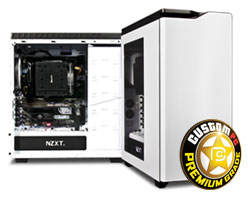SCANZONE
31.07.15 | ISSUE 32
June is a fantastic time to be a PC enthusiast, with two major shows, Computex in Taiwan and E3 in Las Vegas, giving us sneak peaks of hot new technology and games that are coming soon. This month also sees the battle between rival NVIDIA GeForce and AMD Radeon graphics cards turn into all out war with NVIDIA launching one new card and AMD a swam of six new cards. We’ve got full details and analysis of which card is best, along with some great news about Windows 10 and some insight into what makes server-class SSDs different from consumer-grade SSDs’.

1. Upgrade to Windows 10 for free
After several public betas Microsoft has announced that Windows 10 will start shipping on 29th July. Available in nine different versions, including embedded devices, phones and tablets, the two most important editions of the new operating system will be Windows 10 Home and Windows 10 Pro.
While Windows 10 will be a standard retail product, Microsoft is offering anybody with a licensed installation of Windows 7 or 8.1 a free upgrade to Windows 10. This offer will remain open for one year after 29th July. All you need to do is click on the Windows icon in the system tray and register that you’d like to upgrade to Windows 10. The new OS will then download and unlock on 29th July. If you can’t see a Windows icon in the system tray, run Windows Update and make sure to download update KB3035583.
Anybody buying a SCAN 3XS System between now and then with Windows 7 or Windows 8.1 is also eligible for a free upgrade to Windows 10.

2. NVIDIA GeForce GTX 980 Ti review
There’s no denying that the NVIDIA GeForce GTX Titan X is a very desirable graphics card, as it delivers incredible performance, including 4K games. However, with a retail price of £799, for most gamers, Titan X remains a dream rather than a reality.
Enter stage left, the GeForce GTX 980 Ti. With prices starting at a far more affordable £549 this new GPU sits much closer in price to the standard GTX 980, which can be hand for around £400. However, in terms of specs, the 980 Ti is much closer to the Titan X.
For example, while the standard 980 has 2,048 cores, the 980 Ti has 2,816 cores, only a few less than the 3,072 of Titan X. Similarly, while the 980 has 128 texture units, the 980 Ti has 172 units, only a few less than the 192 of Titan X. Even better, 980 Ti has the same 96 ROPs as Titan X, while the standard 980 only has 64. The, 980 Ti has the same 384-bit memory controller as Titan X too, giving it another leg up over the 980, which has a 256-bit controller. Coupled to this memory controller is 6GB of GDDR5, half as much as the Titan X, but still 2GB more than the 980.
With the GPU clocked at the same 1,076MHz as Titan X and barely any games using more than 6GB of RAM, both cards deliver almost identical performance. However, the real competition for the 980 Ti isn’t Titan X, but the AMD Radeon R9 Fury X, which also launched this month. Carry on reading to find out which card is best.

3. AMD Radeon R9 Fury X review
AMD’s last attempt at a high-end graphics card was theR9 295X2, a monster of card featuring two GPUs sandwiched together on one PCB. While the 295X2 was far from elegant, it did deliver incredible performance in games that had good CrossFire profiles, something that many games still lack.
This year AMD has taken a different approach, favouring elegance over brute force with the R9 Fury X being a diminutive card that incorporates a very quiet watercooling system complete with a 120mm radiator. The Fury X is so small because it’s the first card to make use of a revolutionary new type of memory called HBM (High Bandwidth Memory) that is physically integrated into the GPU rather than sitting on the PCB as lots of separate modules.
As its name suggests HBM also provides significantly more bandwidth than the GDDR5 found on other graphics cards. For instance, the Fury X has a staggering 512GB/sec of bandwidth to play with, versus the 336GB/sec of the GTX 980 Ti which also launched this month. HBM is also a lot more power efficient than GDDR5, which coupled with some power saving technologies inside the GPU give the Fury X a modest TDP of 275W, the same as the much slower R9 390X that also launched this month. The only downside to all this cleverness is that HBM is currently only available in 1GB stacks, so the Fury X only has 4GB of memory to play with, which will limit performance in some games at very high resolutions and quality settings.
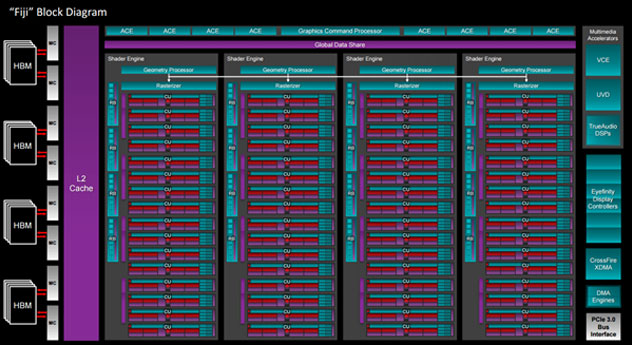
While HBM memory is all about efficiency the Fiji CPU inside Fury X is a beast and could be fairly described as a R9 285 on steroids. And what steroids they are, the Fury X has an incredible 4,096 stream processors, a huge increase over the 1,792 of the R9 285 and 2,816 of the more recent R9 390X as its based on the same GCN 1.2 architecture. This gives the Fury X a staggering amount of performance when it comes to pixel shading, although it has the same 64 ROPs as the R9 390X, which will limit performance in some situations.
As Fury X cards are currently being built by AMD, all the boards are the same, with prices starting at £546, just £3 less than the GTX 980 Ti. To find out which card is king of the hill read on.

4. GeForce GTX 980 Ti vs Radeon R9 Fury X
The competition between NVIDIA and AMD is hotter than ever, with both companies releasing new graphics cards this month. With both boards costing around £550 and being marketed as ideal for 4K gaming here’s my take on both cards, based not only on my own testing but also a summary of what the leading press also found in their reviews.
One of the most popular games right now is GTA V, with this open-world crimeathon proving more than a match for many a graphics card. At very high quality settings at 4K both cards deliver commendable performance, with an average frame rate of 45fps for the 980 Ti and 41fps for the Fury X. However, with the minimum frame rate of both cards of just 17fps leaves a lot to be desired, so you’re either going to need two cards or have to turn down the quality settings to get a smooth frame rate at 4K.
Another popular new game is The Witcher 3: Wild Hunt, which again saw the 980 Ti take the lead with a minimum frame rate of 33fps and average of 38fps. In comparison, the Fury X was a little slower, with a minimum of 25fps and average of 31fps.
The Fury X did manage to take the lead in Middle Earth: Shadow or Mordor, although its minimum frame rate of 43fps and average of 53fps is only marginally faster than the 980 Ti which managed an identical minimum frame rate of 43fps but slightly slower average of 52fps.
In other games such as Thief, Tomb Raider, Dying Light and Dirt 3 the pattern was very much the same, with the 980 Ti proving on average 5-10% faster than the Fury X. It’s not all doom and gloom for AMD though as the Fury X is very quiet and a huge improvement over previous AMD high-end cards such as the R9 290X and R9 295X2. However, with pre-overclocked and custom-cooled 980 Ti cards, which give another 5-10% performance, available for the same price as a stock speed Fury X, the 980 Ti is undoubtedly the superior choice. Both cards are in stock and available to buy from Scan or fully integrated into of one our award-winning 3XS gaming PCs.

5. NVIDIA G-Sync gaming laptops
Until recently the only way to get rid of tearing and stuttering when play games was to buy a G-Sync monitor. Now you can say goodbye to tearing and stuttering on your laptop too, with the introduction of mobile G-Sync.
G-Sync will initially be available on high-end gaming laptops such as those using the GeForce GTX 970M or 980M graphics cards. Scan 3XS has four such options on our 15.6" LG1521-G and17.3" LG1721-G chassis from as little as £1319. Both chassis are completely configurable with your choice of CPU, GPU, RAM and storage and are available with either a FullHD (1920 x 1080) or 4K (3840 x 2160) screen with a high-quality IPS panel that syncs with the output of the GeForce GPU. MSI has also launched three G-Sync variants of its 17.3" GT72 chassis, available from £1619 inc VAT.

6. AMD Radeon R9 390X review
AMD has had a super busy June, not only launching the Fury X (see story above) but also a whole family of Radeon 300-series graphics cards. As revealed in last month’s ScanZone these aren’t brand new GPUs but tweaked versions of the previous Radeon 200-series.
For instance, while the R9 390X has the same 2,816 stream processors as the R9 290X and the same 512-bit memory controller, the GPU clock speed has been boosted from 1,000 to 1,050MHz and its memory clock from 5GHz to 6GHz. Speaking of memory, this has also been doubled, going from 4 to 8GB of GDDR5, a welcome improvement since games have started using a lot more VRAM in the last nine months.
Retailing for around £340, the R9 390X sits mid-way in price in between the GeForce GTX 970 and GTX 980 and provides performance midway between NVIDIAs two cards. Despite the extra VRAM the R9 390X still doesn’t have enough grunt to play games at 4K smoothly, but will deliver good frame rates on a 2560 x 1440 monitor.
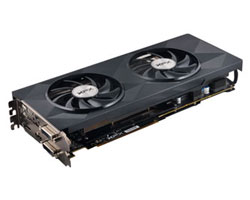
7. AMD Radeon R9 390 review
The second AMD GPU to get the refresh treatment is the R9 390, which like the earlier R9 290 has 2,560 stream processors and a 512-bit memory controller. However, the GPU in the new card has had its frequency increased from 947 to 1,000MHz and its memory clock from 5 to 6GHz. Just like its bigger brother the R9 390X, the R9 390 has double the RAM of the R9 290, giving it a total of 8GB of GDDR5 to play with.
Retailing at a much more affordable £260 the R9 390 is positioned to compete with the GeForce GTX 970, with the former taking the lead in games such as Battlefield Hardline and the latter the lead in GTA V and Dying Light.
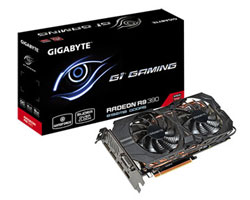
8. AMD Radeon R9 380 review
The next 300-series card in line is the R9 380, which again is a tweaked version of the older R9 280. As such, it has the same 1,792 stream processors and 256-bit memory controller. However, the GPU frequency has been raised from 918 to 970MHz, with the RAM also getting a boost from 5.5 to 5.7GHz. The R9 380 is available in two flavours, one with 2GB of GDDR5, the same as the older R9 280 and a second flavour with 4GB of GDDR5.
The 2GB cards start at £160 while the 4GB cards start at £180, putting them on an equal footing to the GeForce GTX 960. This makes both flavours of R9 380 best placed for gaming on a 1920 x 1080 monitor, with the AMD card giving superior performance in games such as Crysis 3 but slower performance in newer games such as GTA V and Dying Light.
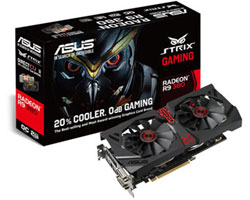
9. AMD Radeon R7 370 and R7 360 review
Further down the range are the two R7 cards, the 370 and 360, with a similar pattern of tweaks and improvements. For instance, the R7 370 is essentially an R7 265, with another 50MHz added to the GPU frequency and the ability to support either 2 or 4GB of GDDR5. With prices starting at £120 for a 2GB card and £140 for a 4GB card, the R7 370 is around £20-40 more expensive than the GeForce GTX 750 Ti, but according to reviews in the media plays games around 5 to 10fps faster, making it a good choice for a low-cost gaming PC.
The final card in the 300-series is the R7 360, which is based on the older R7 260. Again it’s been given another 50MHz on the GPU and has its RAM doubled from 1GB to 2GB. Retailing for £90 the R7 360 can play modern games smoothly at 1920 x 1080 as long as turn down the detail settings to medium or high. The GeForce GTX 750 is the R7 360s nearest competitor, also retailing for £90, delivering slightly slower performance in most games.
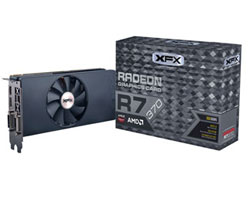

10. The best tech of Computex 2015
The tech industry gathered together in Taiwan for the annual Computex trade show earlier this month. Computex is always a great indicator of the health of the PC industry and this year was no exception with a slew of new products being unveiled for the first time. Here’s a brief summary of some of the more interesting products that were at the show.
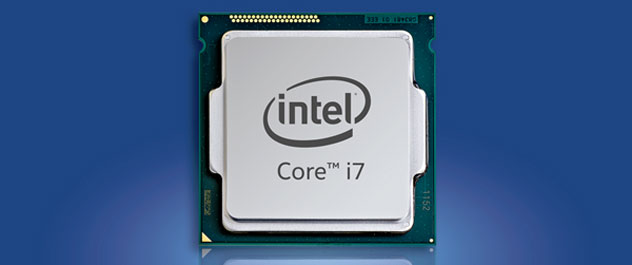
NUC and Ultrabook buyers have been able to take advantage of the super low consumption of Intel’s 5th generation processors, codename Broadwell, since February, so it was great to see Intel launch Broadwell on the desktop at Computex. The launch comprises two models, the Core i5 5675C and Core i5 5775C. Both are made using 14nm transistors, versus the larger 22nm transistors used in Haswell. Like their mobile versions of Broadwell this means the new chips draw considerably less power as a Haswell CPU such as the Core i7 4790K.
However, because the new Broadwell chips have a comparatively low clock speed and a small cache, they are significantly slower in applications such as media encoding and photo editing. On the plus side however the new chips feature a far more powerful on-board GPU than Haswell, with the new Iris Pro 6200 GPU being fast enough to play games at medium quality settings, the first time an Intel GPU has provided this level of performance. The Core i5 5675C and Core i5 5775C are compatible with all Z97 and H81 motherboards via a BIOS update and are available to order from Scan.
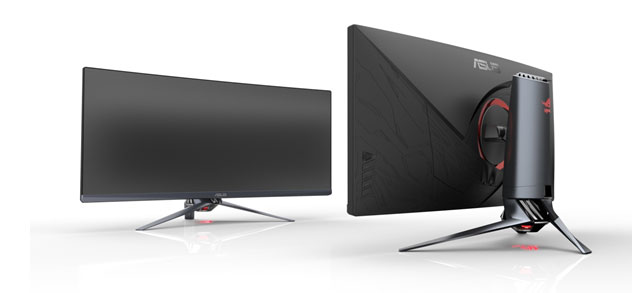
Asus announced dozens of new products at Computex, but for me the highlights were two new Republic of Gamers monitors, both with G-Sync inside. First up is the PG279Q, which features a 27" IPS panel with a resolution of 2560 x 1440. There’s no word on pricing yet, but I’d expect the PG279Q to come in somewhere around the £700 mark. Even more desirable is the 3800R, a curved 34" monitor much like the gorgeous Acer Predator XR341CKA that I wrote about last month. Like the Predator, Asus’s 3800R has an IPS panel with a resolution of 3440 x 1440, making games far more immersive thanks to its ultra-wide aspect ratio. Again there’s no word on pricing yet, but given that the Predator retails for £959 I wouldn’t expect the Asus 3800R to be significantly different in price.

The case wizards at Fractal Design also came up with several new designs at Computex, the most interesting of which is the Node 202. This compact case can be placed horizontally as pictured or sit vertically, making it attractive for anybody looking to build a small but powerful PC. For instance, in addition to its mini-ITX motherboard it can house a dual-slot graphics card up to 310mm long, which basically means almost any card in production today. The only downside I can see if that it requires an SFX power supply, which tend to be quite expensive.
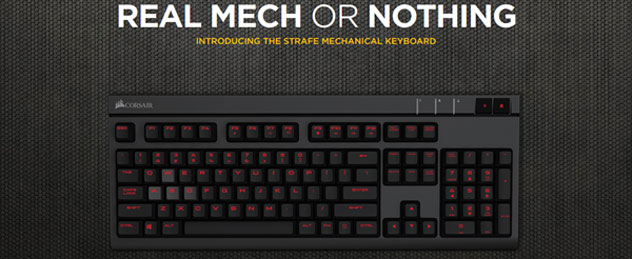
Last year Corsair used Computex to unveil its K70 range of gaming keyboards with a customisable backlight behind every key. This year, it’s the turn of the Strafe keyboard. The Strafe offers a choice of Cherry MX mechanical switches, quiet red switches for general gaming and brown switches that provide an audible click when activated, allowing for faster typing.
Like the K70, the Strafe features individually programmable LEDs behind each key, but to keep costs down the LEDs on the Strafe can only display red. Due for release in August the Strafe is available for pre-order for £99, a significant saving over the K70’s which start at £129.

11. The best games of E3 2015
Every year in June the tech industry gathers on the other side of the world from Taiwan, to show off the latest games at the E3 show in Las Vegas. Here is a shortlist of some of the biggest and most exciting PC games announced at E3, plus a few that have been announced previously but were demonstrated for the first time at this year’s show.

Stealth, magic and stabbing fans should be pleased to hear that Dishonored 2 is on its way. The game will feature two playable characters, Corvo from the original and former-Empress Emily Kaldwin and is scheduled for release in spring 2016. Here’s the Dishonored 2 trailer.

Doom may have been announced at last year’s E3 but gamers have had to wait a full year for their first glimpse of actual gameplay. As the Doom trailer patently makes clear, the latest outing of the franchise marks a return to the series’ roots, ignoring the ponderous Doom 3 in favour of high-speed brutal run and gun gameplay. The trailer features plenty of blood, guts and some pretty horrific finishing moves with the chainsaw so if you’re of a nervous disposition then it’s probably not a good idea to watch the trailer. Doom is scheduled for release in spring 2016.

Fallout 4 sees the post-apocalyptic role playing game move the action to Boston, promising more customisation and crafting options than previous games in the series. Fallout 4 is due for release on 10th November this year with the trailer capturing the tone of the earlier games perfectly. Let’s just hope that the writing is more in line with Fallout New Vegas than Fallout 3, which had a frankly soporific main story.

Hitman Absolution may have been a console-centric mess, but hopefully the sixth game in the series, for some reason just called plain old Hitman, will see the franchise return to the greatness of the past. There’s no gameplay footage at the moment, just this cinematic trailer to feast your eyes on, although with a release date of 8th December this year there’s not long to wait for the full game.

Mass Effect was originally written as a trilogy, so the fourth game in the series, subtitled Andromeda takes place in a new galaxy with a new set of characters. The cinematic trailer keeps referring the N7 suit that Shepard wore in the first games, but it’s not clear who you’ll get to play this time. Either way, we’ll be waiting a while as Mass Effect Andromeda isn’t due for release until winter 2016.

Sea of Thieves is Rare’s latest game, putting a musket and cutlass in your hand in this multiplayer pirate game that looks like an excellent blend of Pirates! and Mount & Blade. There’s no release date yet, but there is a very stylish trailer to view in the meantime while doing your best pirate impression.

There hasn’t been a good Star Wars computer game for years, but Battlefront looks simply awesome, blending the best of Battlefield-style gameplay with classic scenes from the original films such as battling AT-AT walkers in the snowfields of Hoth. You can check out the gameplay for yourself in this extensive trailer, before the game is released on 17th November this year.

12. Intel data centre SSD review
Intel has been at the forefront of SSD storage since for several years, and has over the last year been busy releasing a range of drives specially engineered for the special demands of the data centre. This environment is particularly challenging for any storage device as unlike a desktop or laptop PC, a server is typically powered up and active 24/7.
For this reason, a server-grade SSD needs to be able to read and write data not just quickly, but consistently. In contrast, if you used a consumer SSD in your server, then whoever is connected to the server, be it hosting a database or hosting a game may experience sub-standard service.
To see if there is any truth to this assertion we put 16 different SSDs through a rigorous set of performance and consistency benchmarks. The mixture included a range of the latest Intel PCI-E and SATA SSDs plus a variety of SATA drives from other reputable SSD vendors such as Samsung, chosen because they are popular with many customers who buy SSDs from Scan.
Benchmarking SSDs is very challenging because most drives, particularly consumer SSDs have been specifically engineered to give excellent peak performance, which after a short time tales off as the controller struggles to keep up with demand. For this reason, before benchmarking we secure erased and then pre-conditioned every drive by running a continuous sequence of 4KB sequential writes for one hour so that all the flash cells had been fully written to at least once.
The first test conducted on all the drives was to measure their performance using CrystalDiskMark, which includes eight different profiles. Each of these is designed to test a drives ability to read and write different types of data. Rather than presenting the 8 different benchmark results from all 16 drives, which is enough data to give anyone a headache here’s a subset of the most interesting results.
For instance the first two graphs shows each drive reading and then writing 128KB of sequential data, using 1 CPU thread at a queue depth of 32. As you can see the reported results, in MB/sec are extremely impressive, which is why these are the results that SSD manufacturers quote on their tech specs when marketing a new drive. It’s also worth noting here that the graphs clearly show the world of difference between the three PCI-E drives (highlighted in red) and the four SATA drives (highlighted in blue) – the former are clearly in a league of their own.
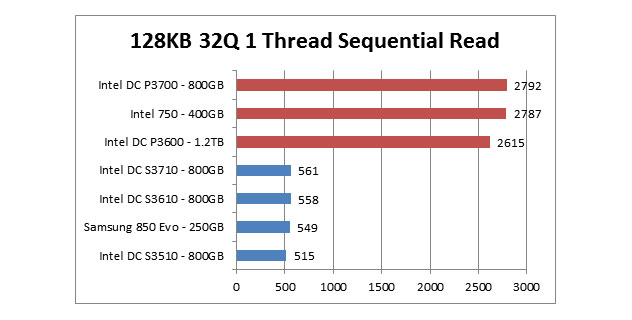
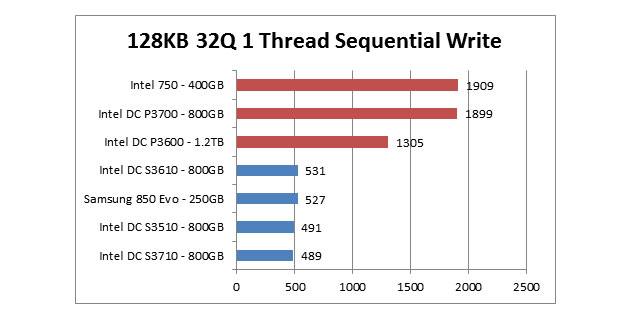
However in the real world, applications and games don’t simply read and write data in such a simplistic way, instead mixing and matching transfer sizes and queue depths along with a blend of sequential and random stored data.
For instance the following graphs show the drives reading and then writing 4KB of random data, using 1 CPU thread at a queue depth of 1, which is a good simulation of how many applications and games behave when loading. As you can see, all the drives found this task much harder than the previous test and that the three PCI-E drives didn’t show nearly as much of a performance advantage during this test than in the previous more synthetic scenario. This shows that a server grade PCI-E is overkill for a gaming PC or laptop as you simply won’t see enough of a performance benefit to justify their higher cost. That said, when writing data the two Intel server grade SSDs, identifiable by their DC branding still led the pack by a considerable margin.
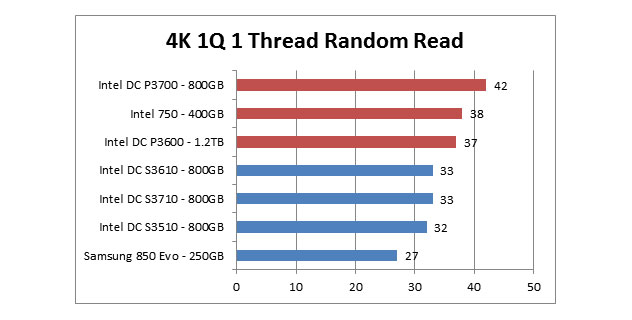
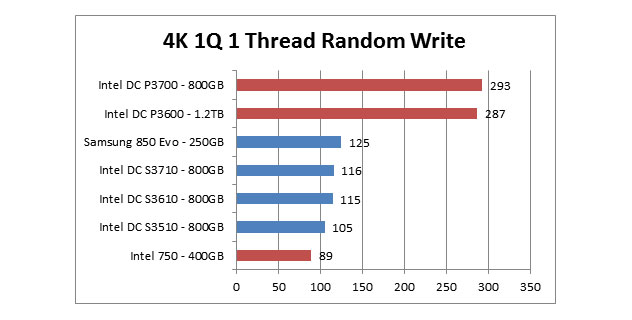
Changing the benchmark parameters by increasing the queue depth to 32, which is more in line with the sort of workloads a SSD in a server is likely to face shook up the field considerably. Once again, the three Intel PCI-E drives took the lead, reading and write more than twice as fast as their SATA competitors, showing the massive advantages these types of drives could bring to your servers.
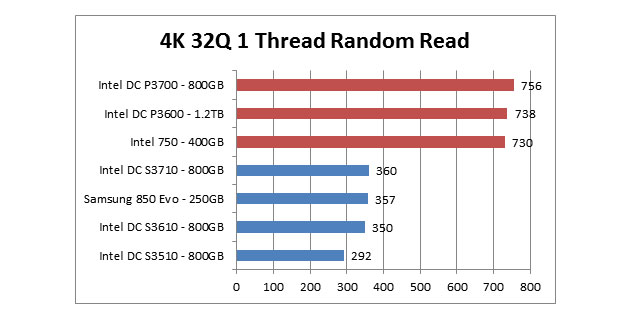
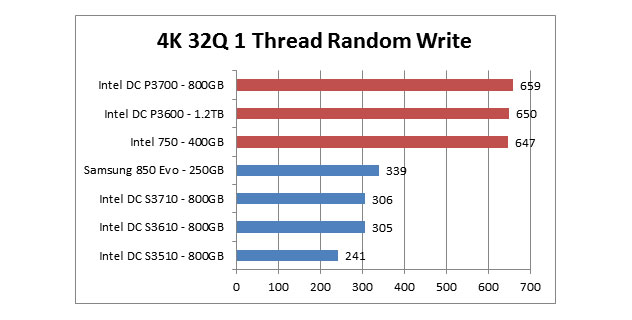
However, as good as these results are, they don’t tell the full story. That is because consumer SSDs are only engineered to deliver peak performance for a few seconds rather than sustained performance for hours or days on end.
To see how much difference there is between consumer SSDs and a server-grade SSDs we created a custom server benchmark using the storage utility Iometer, comprising 2 hours of random 4KB writes at a queue depth of 32. This was then run on three pre-conditioned SSDs, the most popular consumer SSD, the SATA 250GB Samsung 850 Evo, and two server-grade SSDs, the PCI-E 800GB Intel DC P3700 and SATA 800GB Intel DC S3710.
The results were very interesting, with the Samsung 850 Evo displayed in green, the Intel DC P3700 represented in blue and the Intel DC S3710 in red. The vertical axis is the number of write IOPS each drive was doing, logged every second, as shown in the horizontal axis over the course of the two hour test run.
What the graphs clearly show is that once Windows and the drive’s own caching algorithms have been exhausted all three drives produced remarkably consistent performance and are far more consistent than SSDs from a few years ago, which is good news whatever class of SSD you buy.
What’s even more apparent from the graph is that for sustained performance the two server-grade Intel SSDs are clearly in a league of their own, with the Intel DC P3700 averaging 99,588 IOPS and the Intel DC S3710 averaging 41,049 IOPS compared to just 5,128 IOPS from the Samsung 850 Evo.
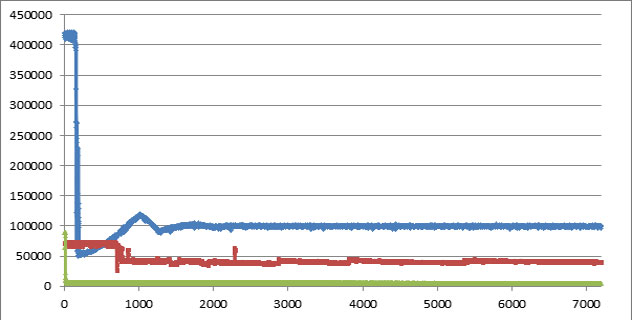
Even if you were to zoom in the graph into the second half of the test, so the vertical scale doesn’t take into account Windows and drive caching, the performance difference between the consumer and server-grade SSDs is just as stark, with the consumer SSD still lolling at the bottom of the graph.
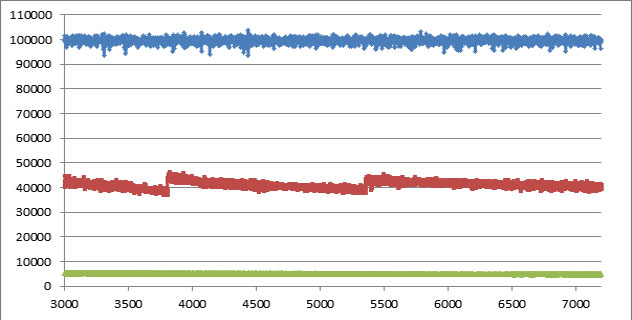
Scan stocks the complete range of server-grade Intel DC SSDs, both in SATA and PCI-E versions, with read and write optimised drives available depending on your requirements and budget.

13. Have your say about shopping with Scan
Scan is delighted to have been nominated again in this year’s PC Pro Awards. The awards are voted for by the public, so you can shape which companies and products win awards by going to the awards website and registering your opinion. We’d love to hear what you think. Completing the awards survey will also enter you into a competition to win some fantastic prizes including a quadcopter and a tablet.

14. Winners of the FilmDoo poster competition revealed
Scan Pro Video, a major sponsor of the FilmDoo Fan Art Film Poster competition, were just as excited as the prize winners when the results of the competition were revealed to a capacity audience in the Next Pavilion at Cannes, the world’s most prestigious film festival. The location, (Cannes digital forum), was particularly appropriate for digital ambassadors Scan Pro Video, and the winning artists, Marie Bergeron from Montreal, Canada, Ollie Boyd from Kirkcaldy, Scotland and Ben Holmes from London, were delighted to gain their share of the prize pot, which included for each a £1,000 voucher to spend at Scan Computers, plus prizes from Adobe, NVIDIA and other sponsors.
A panel of industry experts judged over 1000 pieces of artwork for the Filmdoo Competition, which re-imagined promotional posters for iconic films. ‘We had a great range of entries and a really good standard’ said jury member Mia Matson, designer of the original poster for Reservoir Dogs. Scan Pro Video were delighted to be involved because of Filmdoo’s innovative work in connecting audiences around the world with international cinema via their online film discovery platform www.filmdoo.com.
The competition winners now have the opportunity to work on a poster for a major film release. Keep your eyes open at multiplexes near you!
You can find out more on the Scan Pro Video Blog.

Scan 3XS X99 Nanu Carbon review
HEXUS has just reviewed Scan’s miniature GeForce GTX 980 Ti system, the 3XS X99 Nanu Carbon, describing the small form factor gaming system as ‘a rip-roaring performer’ and giving it a Recommended Award. The X99 Nanu Carbon is a mini-ITX gaming PC featuring a 6 or 8-core Intel Core i7 processor, GeForce GTX 980 Ti graphics and ultra-fast PCI-E SSD storage.
The review went on to say that ‘Scan's build quality is tidy as always, and it's on small-scale rigs such as these that you really appreciate a turnkey solution. The other key benefit of a Scan pre-built PC is the guaranteed and insured overclock. Well thought out and built with performance in mind, the 3XS X99 Nanu Carbon is one of the smallest gaming PCs we've tested’.
The review concluded that ‘Scan's 3XS Nanu Carbon is a good example of what a modern high-end PC can be. Taking advantage of some of the very best that technology has to offer, it combines a hexa-core Intel Core i7-5820K processor, powerful GeForce GTX 980 Ti graphics and an insanely fast Samsung PCIe SSD to deliver exceptional all-round performance and real 4K gaming potential. The 3XS X99 Nanu Carbon offers plenty to admire and, if you're seeking high-end gaming thrills without the bulk of a towering rig, Scan's pocket rocket is the kind of PC you want.’
You can read the full review of the system on HEXUS.
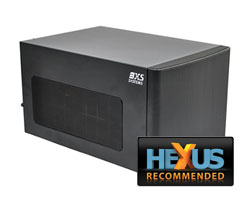
Scan 3XS X99 Carbon Ti review
The August issue of Custom PC includes a review of our new high-end gaming PC, the 3XS X99 Carbon Ti, which features the new NVIDIA GeForce GTX 980 Ti graphics card that launched earlier this month.
CPC loved the system giving it a score of 90% and a Premium Grade Award, writing that ‘Scan's choice of components is clever and powerful. Scan's 3XS X99 Carbon Ti has two components that attract more attention than most: NVIDIA's brand-new GeForce GTX 980 Ti graphics card sits in the middle of this machine, and just below it sits Samsung's new SM951 - the first M.2 SSD we've seen to use PCI-E 3. The Scan is near silent at idle and only produced a low consistent rumble when running tough games.’
The review concludes that ‘Rapid speed from every component and a slick design, make the 3XS X99 Carbon a superb gaming machine.’
